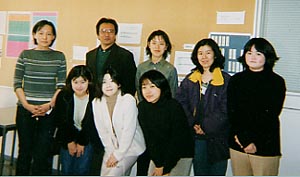  |
 |
 |
|
The
Newly Established Experimental Animal Facility in the BSI Central Research Building
| Yoshihiro
Sugiyama |
| Research
Scientist Advanced Technology Development Cente |
|
 |
 |
| Staff
of the Experimental Animal Facility(Myself,2nd person from top left) |
When
I started managing the Experimental Animal Facility, which had only 18 rearing
rooms and about 4,000 cages, in the East Research Building last year, I had the
impression that it was about the same size as the university I was previously
at (I was transferred from the experimental animal facility affiliated with the
university). Before long, I also noticed that there were more high quality administrators
attending to the animals than at the university level and that the staff were
very knowledgeable about animal rearing. Last May, at about the time I was just
getting used to the environment at RIKEN, the Experimental Animal Facility in
the BSI Central Building was reaching partial completion (the 1st stage). The
remaining, 2nd stage, is expected to be completed by July of this year.
When all of the work is completed, the Experimental Animal Facility in the Central
Research Building will have the capacity for rearing up to 120,000 animals, with
about 20,000 cages, and will be one of the premiere facilities in Japan that rear
only mice and rats. This facility, whose function is to create, rear, and breed
genetically-modified (transgenic) animals, uses micro-ventilation rearing equipment
for all animal-rearing projects and is equipped with the latest cages which can
be ventilated on a unit basis. This rearing equipment makes it possible to lower
the concentration of ammonia, to stabilize the humidity inside the cages, and
to supply more fresh air. Another advantage of the new equipment is its ability
to create positive pressure inside the cages for preventing the infestation of
disease-causing germs and other harmful substances that may enter the cages. For
drinking water, purified water, not tap water, is used so that the water does
not affect the experiments due to reverse osmosis membranes. Also, fodder sterilized
with radial rays is exclusively used for animal food. Moreover, all rearing rooms
are equipped with several sensors for conducting 24-hour monitoring.
In the cleanest area, mainly breeding and long-term rearing experiments (for pedigree
maintenance, senescence, experimental breeding, etc.) are conducted and top priority
is given to maintaining cleanliness. This area is also equipped with machines
and devices for creating genetically modified animals. In the semi-clean area,
animal experiments, breeding and long-term rearing are in principle not carried
out. Meanwhile, in order to facilitate animal experiments, the laboratories in
this area come complete with testing equipment that allow for behavioral observations,
so it is therefore not necessary to bring the animals out from the facility. Accordingly,
we work in a system in which animals bred in the clean area are reared and tested
in the semi-clean area. In addition, this facility only accepts clean animals
which do not carry specific pathogenic microorganisms as test animals and refrains
from accepting animals from facilities where pathogenic microorganism monitoring
is not conducted. These measures are taken so as to prevent the accidental loss
of genetically modified animals.
Currently, I am extremely busy upgrading the software, since such top-class hardware
cannot run at its true potential unless the operational management software is
fully adequate. As I did not participate in the design of the experimental animal
facility, there are some points that remain to be clarified such as a clearer
purpose, design intentions, as well as other matters. However, it is an interesting
challenge to participate in the facility's operations while at the same time trying
to guess what the designer had originally intended.
What I do know from my involvement in the facility up to this point is that constructing
an animal facility "piece by piece" creates unique challenges. In the facility
that was completed last year, animal rearing and testing have already been underway.
Now, a new facility has been built and annexed to the existing one. Joining the
two buildings is done easily enough during the course of construction, but it
is difficult to maintain the cleanliness of the biological environment and thus
is a rare method of constructing an experimental animal facility. Having observed
the building site immediately before the completion of the 2nd-stage of construction,
I now believe that it would have been easier to get these facilities up and running
had they been independent of each other. However, as researchers have a strong
desire to conduct experiments and place top priority on their own research, even
this kind of large-scale experimental animal facility will no doubt be buzzing
about with animal activity soon after its completion. As researchers continue
to adjust to the new facility, I am confident that great strides will be made
in the area of animal research. |
  |
|
|






